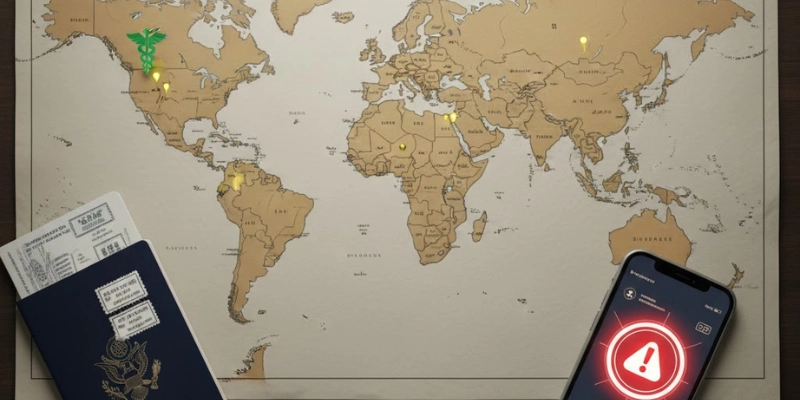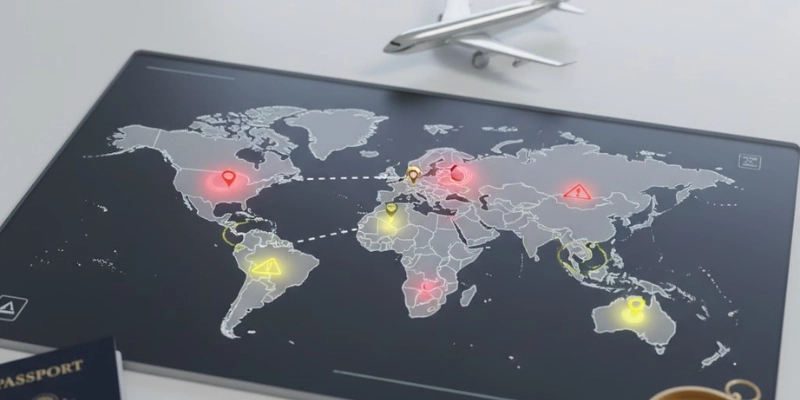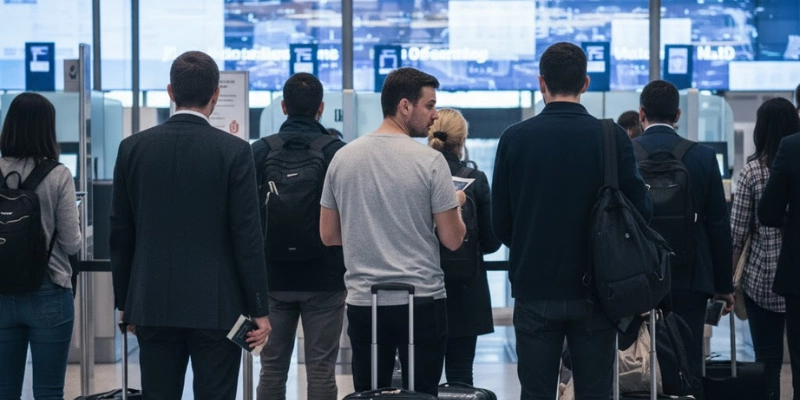Complete UK & US Travel Advisory Updates 2025 – Full Guide
Published: 13/10/2025
Travel advisories guide people before they plan a trip. In 2025, both the UK Foreign, Commonwealth & Development Office (FCDO) and the US State Department released updated travel advice for different countries. These updates highlight essential safety rules, entry requirements, health risks, and regional warnings that every traveler should be aware of.
This article provides an update on the latest UK and US travel advisory changes for 2025, drawing on insights from The Atlantic to offer a clear picture of how these developments impact international travel.
Let’s go through the updates step by step.
What are Travel Advisories, and Why do They Matter
A travel advisory is an official message from a government about safety, health, or security risks in another country. It helps people decide whether to go, change plans, or take extra precautions. Advisories usually cover:
- Violence, war, or crime
- Health issues like outbreaks or major illnesses
- Natural disasters such as floods or earthquakes
- Local rules and limits that affect foreigners
Governments do not force you to stay home, but their advice can affect insurance, help from embassies, and your personal risk. If a place is under a strong warning, many insurers and tour companies may refuse service. For the most reliable updates, please visit the official pages listed below.

Comparison Chart: UK FCDO vs US State Department Travel Advisories
| Feature | UK FCDO (Foreign, Commonwealth & Development Office) | US State Department |
| System Style | Country-by-country guidance with maps and detailed notes | Four-tier warning scale (Levels 1–4) |
| Risk Levels | Safe to travel, avoid some areas, avoid all travel | Level 1: Normal PrecautionsLevel 2: Increased CautionLevel 3: Reconsider TravelLevel 4: Do Not Travel |
| Update Frequency | Frequent, updated after major incidents | Frequent, plus global alerts |
| Extra Features | Clear maps showing risky areas, local safety tips | Worldwide alerts for security risks (terrorism, global events) |
| Communication Tools | Email alerts for citizens | STEP program registration for alerts |
| Tone | More descriptive and advisory | More categorical and direct |
Quick View – How the UK and US Systems Differ
The UK and the US both publish travel advisories, but they use different systems. The travel advisory America gives country-by-country guidance with clear risk levels, while the US ranks countries in four tiers, from “Exercise Normal Precautions” to “Do Not Travel.”
United Kingdom (FCDO)
The UK uses clear guidance like:
- Safe to travel with normal care
- Avoid some areas inside a country
- Avoid all travel to parts of a country or the whole country
The UK pages also show maps and explain exactly which cities or border zones are risky. You can sign up for email updates and read details for each country.
United States (State Department)
The US uses a four-level scale:
- Level 1: Exercise normal precautions
- Level 2: Exercise increased caution
- Level 3: Reconsider travel
- Level 4: Do not travel
The higher the level, the more serious the danger. The US also issues worldwide security alerts when global risks rise. These alerts tell US citizens to be extra careful no matter where they are.
Traveler Personas and How They Read Advisories
Not every traveler looks at advisories the same way.
Backpackers often check for local risks like border safety, transport strikes, or hostel security.
Business travelers pay more attention to entry rules, visa changes, and airport safety.
Family tourists usually focus on health risks, insurance coverage, and avoiding areas with unrest. Knowing how different types of travelers read advisories helps highlight why these updates matter for everyone.
Travel Safety Tips 2025 — Based on UK & US Advisories
Below are the main patterns for 2025 that affect many travelers.
1. War Zones and Places with Armed Conflict
Areas affected by war remain at the top of the list. Countries such as Syria, parts of Ukraine, and some regions in Yemen and Libya are commonly labeled as places to avoid because of fighting and the risk to civilians. Both the UK and the US continue to advise people not to travel to active conflict zones.

2. Rising Tensions in the Middle East
In mid-2025, the US issued security alerts and warnings for Iran, Iraq, Israel, and Jordan after military strikes and rising threats in the region. These alerts warned of possible missile or drone attacks and advised citizens to avoid certain areas or to shelter in place if needed. Governments sometimes close airspace or disrupt flights, which makes travel risky.
3. Crime and Kidnap Risks in Parts of The Americas
Some areas of Mexico, parts of Central America, and certain cities in South America are marked as high risk for violent crime and kidnapping. The US often labels some Mexican states as Level 4 or Level 3, depending on local trends. Tourists should avoid high-risk zones and follow local advice.
4. Health and disease notices remain important
Travel Health Notices continue for outbreaks such as dengue or other infectious diseases. Even when borders are open, local health risks can affect your trip. Check health notices and vaccine guidance before you go.
The Atlantic’s View – How Policy and Tone Affect Travel Choices
The Atlantic has covered how recent policies and enforcement actions can change how people feel about travel. For example, reporting in 2025 shows travelers worry about stricter US immigration checks, and there has been a drop in some kinds of tourism after certain policy signals.
This kind of reporting matters because it shows that official advice is only one factor. People also react to the tone and actions of governments, and that reaction can cut travel between countries. If travelers feel unwelcome or fear detention at airports, they may cancel or pick other destinations.
What this means for you: even if an official advisory says a place is safe, headlines or policy changes can still affect your trip — from visa delays to higher scrutiny at the border. Keep this in mind when choosing dates and airlines.

Practical Travel Steps for 2025
Follow these steps to reduce risk and avoid last-minute problems:
- Check official advisories: Look at both the UK FCDO and US State Department pages for your destination. Each may provide different insights, and both are useful.
- Sign up for alerts: Enroll in FCDO or US STEP programs to get real-time updates while traveling.
- Buy travel insurance: Make sure your policy covers emergencies. Check these details carefully:
- Medical coverage: Hospital stays, doctor visits, and emergencies abroad.
- Medical evacuation: Transport to another city or country if needed.
- Trip cancellation: Reimbursement if your trip is canceled due to illness, advisories, or emergencies.
- Trip interruption: Coverage if you need to cut your trip short unexpectedly.
- Lost or stolen belongings: Luggage, passports, and personal items.
- Political or security evacuation: Protection if you must leave a high-risk or “do not travel” zone.
- Know your embassy contacts: Keep offline copies of your embassy or consulate numbers in case phone networks fail.
- Avoid risky areas: Stay away from border regions, protests, and local hotspots that may change quickly.
- Plan flexible travel: Allow extra time for visa checks, airport procedures, and potential delays caused by sudden policy or news updates.
Real Examples From 2025 to Learn From
- Mexico: Some states are Level 4 due to crime. But tourist spots may be Level 2. That means you can still visit popular resorts with caution, but avoid travel to dangerous states.
- Middle East: In June 2025, a flurry of security alerts urged travelers to avoid certain areas because of missile and drone risks, and some embassies advised citizens to shelter in place or leave if possible. This shows how fast a safe-looking trip can turn risky when military activity rises.
- Perception of the US: Some Atlantic reporting shows that policy moves and stronger border enforcement have changed how foreign tourists and professionals view travel to the US, which can reduce visits or lead travelers to choose alternative destinations.
| What to do if your destination appears on a “do not travel” list |
|---|
|
FAQs
No. They are advice, not laws. But airlines, insurers, and employers often treat them like rules. If a country is marked “do not travel,” many services will not provide support.
Very often. If a major event happens, governments update advice within hours or days. Always check before booking and again right before you fly.
Use official sources first: the UK FCDO for British travelers and travel.state.gov for US travelers. For deeper context, follow trusted journalism such as The Atlantic.
Yes. Many insurers will not cover you if you visit a country listed under “Do Not Travel.” Always read your policy closely.
The UK gives country-by-country guidance with plain safety notes. The US uses a four-level system: Level 1 “Exercise Normal Precautions” to Level 4 “Do Not Travel.”
Usually yes, unless that country itself has closed borders or suspended visas. The warning is about risk, not permission.
Advisories are based on local risks such as crime, conflict, terrorism, natural disasters, or health outbreaks. Sometimes politics also plays a role.
Not directly. Airlines make their own decisions, but if a warning is strong, carriers may cut routes. Always confirm with your airline.
Yes. Registering makes it easier for your embassy to contact you in an emergency or help you if you lose documents.
A: Bookmark the official advisory page, sign up for email or text alerts, and follow local news in the region you’re visiting.
Final Thoughts
Travel advisories change often, so always check the UK FCDO or US State Department websites right before your trip. Even a small update can affect your plans.
Media reports also matter. News about airport checks, visa delays, or security issues can shape the travel experience. Following trusted outlets helps you stay ahead.
Good preparation goes a long way. Carry copies of your documents, buy solid travel insurance, and register with your embassy if possible.
Safe travel isn’t about avoiding risks completely — it’s about planning smart and staying informed. With the latest updates and a little preparation, your journey can be safer and less stressful. Ready to plan smarter?
Let’s put this advice into action for your next trip.

- Be Respectful
- Stay Relevant
- Stay Positive
- True Feedback
- Encourage Discussion
- Avoid Spamming
- No Fake News
- Don't Copy-Paste
- No Personal Attacks

- Be Respectful
- Stay Relevant
- Stay Positive
- True Feedback
- Encourage Discussion
- Avoid Spamming
- No Fake News
- Don't Copy-Paste
- No Personal Attacks


